Regenerative Earth Decade
Call for Action: Ten Points for Climate Stabilization
© 2024 Excerpt from Droege, P. 2024. Climate Engineering by an Intact Biosphere. LISD Prepublishing Service

Of paramount importance in the struggle to resuscitate Ecosystem Earth’s climate stabilization capacity are ten measures to regenerate and retain the biosphere’s ability to maintain a stable climate. Addressed and called upon are local, state, national, and international governments, businesses, community groups, military establishments and civic institutions.
1 Real Climate Goals
Climate neutrality, an equally popular and vague goal of current climate policy, is insufficient to avoid a collapse on the scale of prehistoric climate catastrophes. Even the so-called zero-emission targets are inadequate: the current and exponentially increasing greenhouse gas (GHG) concentration levels are already far too high for this. Both are dangerously misleading and promote complacency. It must be assumed that – due to system inertia – a rapid rise in temperature does not follow overnight, but by a delayed time interval, analogous to the observed and calculated paleoclimate history. The long-term stable atmospheric CO2 level – during the 2.5 million year Pleistocene – peaked at 280-300 millionths – parts per million, or ppm (Da et al. 2019, and Figure 7). Current levels have reached 424 ppm at the time of writing this paper: this is over 150% of the long-term stable concentrations. Humanity has only been living with the elevated concentrations of over 300 ppm CO2 for about 70 years: since the 1950s (NOAA 2023). The delayed temperature kick is only beginning to be felt.
While long-term stable methane concentrations peaked at 600 billionths – parts per billion (ppb) – in the last 800,000 years, current levels will soon exceed 2,000 ppb, i.e. more than 300% of the proven stable level (Figure 8) – in Arctic and other hotspots this is already much higher (Figures 9 a and b). Not 1.5 degrees must therefore be the actual ‘target’: Zero degrees above the 1750 value is much more likely to be climate stable. Given excessive GHG levels ideas about ‘emission budgets’ are fallacious: such budgets have not actually existed any more for at least the past thirty years or more. Atmospheric CO2 concentrations implied in calls for climate neutrality by 2050 are therefore not only far too high – they should lie well below current levels.
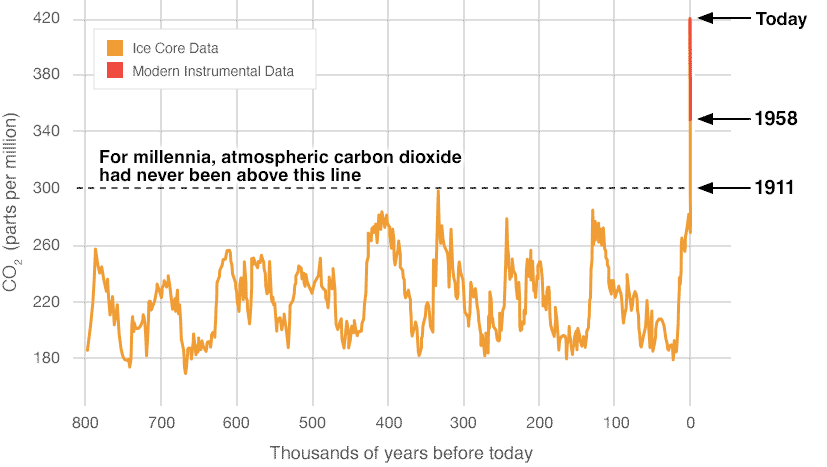
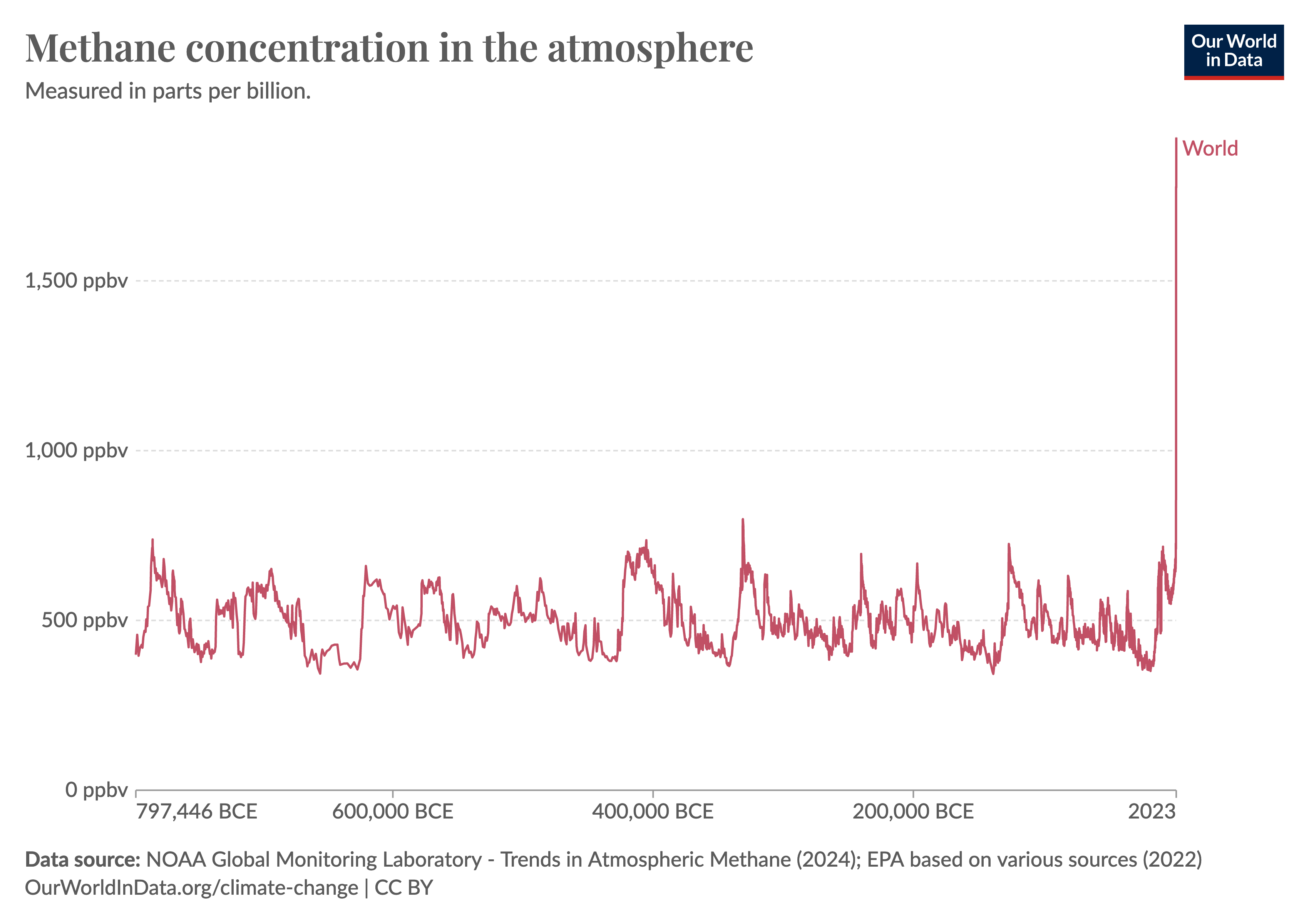
Figures 7 and 8: CO2 and CH4 concentrations in the atmosphere are presently at 150% and 300% of long-term stable values (NASA 2024 and NOAA in OurWorldInData.org (2024). NASA source: NOAA Creative Commons CC0 License. OurWorldInData.org source: CC BY.
The world needs strategies to reduce GHG concentrations in the atmosphere by reversing the flow of emissions. This is also needed to slow fatal warming effects such as the melting of marine methane hydrates, and the thawing of permafrost: it began already decades ago, further accelerating CH4 volatilization in climate feedback, threatening to release potentially large flows of ancient thermogenic methane from deep basins beneath the Arctic seafloor (Steinbach, Holmstrand et al. 2021, Birchall, T., Jochmann, M. et al. 2023) or both thermogenic and biogenic methane accumulating under and seeping through the Svalbard permafrost layer. Figures 9 a and b show the accumulation of elevated methane concentrations over the southern reaches of the Arctic Ocean at surface, and accumulating above the entire Arctic at 5,500 meters, ie mid-Tropopause elevation, as registered at the time of completing this paper. (CAMS 2024)
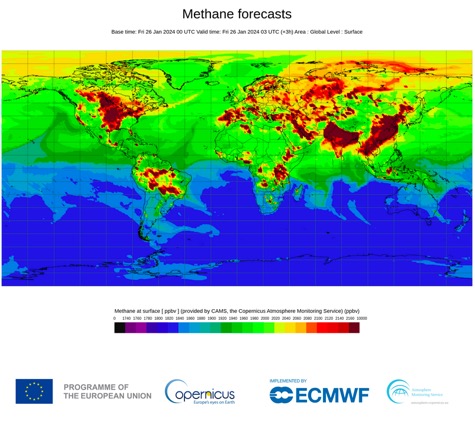
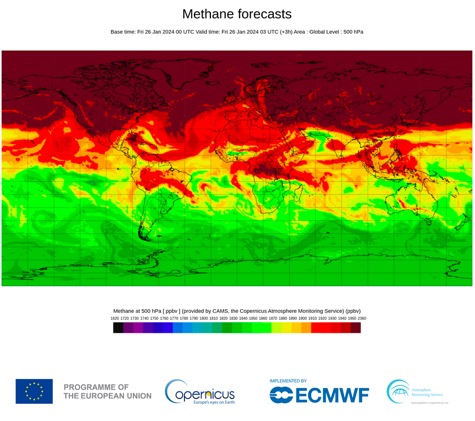
Figures 9 a and b: Methane concentration forecasts at surface level (a) and at 5500 m above sea level (500 hPa – b) forecast of 26 January 2024. In Figure 9 a please note the extensive methane plumes over the southern Arctic Ocean extensions north of Scandinavia, Novaja Semlja to Siberia, from the Barents across the Kara to Laptev Seas to the Anjou Islands, despite the present reading being taken in mid-winter. These still pale in comparison to the extensive other methane hotspots across the globe, such as the industrial, agricultural and other North American, European, Persian Gulf, North Indian, East Chinese and Southeast Asian sources (CAMS 2024). Open Copernicus Product License.
If there was an effective policy and implementation push for broadly coordinated climate stabilization measures, this would also manifest itself in public and widely relayed and reported information: atmospheric, oceanic and terrestrial carbon stores and fluxes, dynamic biodiversity data and chemical pollution flows, all conveyed as part of a global reporting system. It would alert the global human civilization to threats, failures and successes, and could help coax it away from a catastrophic state of emergency fatigue and complacency.
All this means that the current and long-held, seemingly pragmatic but deeply flawed emission goals and temperature targets have to be changed to 280 ppm atmospheric CO2 concentrations (now at 424 ppm); 150% carbon emission reductions; zero degrees Celsius above preindustrial levels (now at 1.5 degrees, at a monthly global average); and 100% renewable energy, as defined here as ‘Real Renewables’: a) replenished in the same time frame as their use; ie that do not rely on future or past actions; b) are carbon free, ie without biomass burning or deforestation for biofuel production; and c) are delivered sustainably, ie in keeping with the 17 United Nations Sustainable Development Goals (UNDESA 2024).
In the currently skewed economic environment favouring incumbent and short-term return-minded wealth accumulators this will not take place without political action and legislative commitments to action. Voluntary action pledges, target setting and guidelines have not proven to be sufficient, and even substituted for actual change. To promise success, public news and well-funded scientific media must unflinchingly inform the global community about this threat in factual and accurate ways. Social and informal media are important where the ownership patterns of the mainstream outlets cause them to fail in their duty.
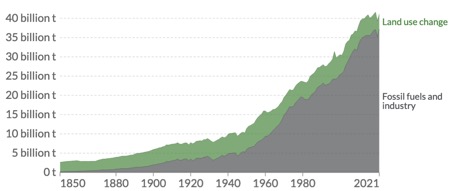
Figure 10: Annual carbon dioxide emissions growth from fossil fuels and land use change including agriculture and forestry from 1850 to 2021. The largest share came from burning fossil energy resources: coal, natural gas and oil (73.2%), with the most dramatic increase since the 1950s), followed at a distance by land use (18.4%), industry including cement production (5.2%) and waste (3.2%). (Roser, 2023). CC BY 4.0 Deed.
2 Climate defense budgets
The emergency introduction of national climate defense budgets for the rapid phase-out of fossil fuels and the switch to renewable energy and other regenerative practices have been postponed for far too long. The size of such national climate defense budgets could amount to five to ten percent of the gross national product, or four to eight times the average national military household that should be reallocated to climate defense measures at least in part. This is only a conservative estimate: the economic share of the United States for mobilisation in World War II quickly exceeded these levels soon after the it was entered into. The global economy must be prepared for this level of readiness, both in terms of effort and immediate commitment. Climate defense is not only a matter of de-fossilizing the energy system but also of mobilizing all possible ways of allowing the recovery of terrestrial and oceanic ecosystems and their climate stabilizing carbon management capacity.
3 Climate peace diplomacy
An important and hitherto novel endeavour among the required emergency measures is Climate Peace Diplomacy. Indeed, and shockingly, it so far entirely untried. It would seek the ending of wars and military aggression in the common interest in the fight for survival – against the common enemy of global heating (LISD 2021) that threatens the complete ravaging of the biosphere. Climate peace diplomacy also includes an unwavering focus on managing climate migration to militate against an inexorable risk for future conflict – see also Point 10 below.
In order to reach global climate peace agreements, intensive engagements and exchanges are not only crucial at the highest levels. Diplomatic channels for peaceful cooperation must be mobilized at all levels. To avert the ultimate catastrophe in humanity’s short history, peaceful agreement and unification for comprehensive climate stabilizing action are fundamental and indispensable. The common aim of establishing determined climate defense budgets and comprehensive climate diplomacy strategies is the rapid shift to renewable energy, the regeneration of agricultural soils and practices, the nature-healing task of renaturation and restoration of deforested areas and wetlands, measures of biodiversity conservation and enhancement – to name but a few of the most important areas. This also requires a new and global monetary framework that places planetary support plans above short-term individual gains.
4 Regenerative financing mechanisms for the global and planetary commons
Long-known but still underdeveloped mechanisms have to be applied to reward long-term investments on a large, systemic scale: in de-fossilization, regenerative agrarian reform, ocean safeguarding and forest protection – in ways that afford higher returns than short-term investments do, for example by inverting the rate of interest rate at the point of credit money creation. A universe of demurrage driven, investment tagged and tracked smart environmental instruments needs to be activated to support the financial transaction space required to shift the reward structure of investments from short- to long-term. The current monetary system needs to be complemented by a rich ecosystem of reward and investment instruments that are geared towards biospheric intactness, boosting shared ecosystem services from atmospheric carbon sequestration to biodiversity support. This new monetary framework is needed that prioritizes planetary support schemes over short-term individual gains. This may include carbon fintech solutions without the conventional polluting offsets, capable of creating a new market for regenerative goods and services that can be clearly and unmistakably registered. This way a distributed and diverse ecosystem of global, national, regional and local currencies, fiscal tools and financial systems can be created to enable the newly redefined Global Commons of a stable climate, healthy biomes, fresh water, regenerative agriculture and others (Magalhães 2023, GEF 2019), and the ‘Planetary Commons’ of “safeguarding Earth-regulating systems in the Anthropocene” (Rockström 2024).
5 Fossil fuel source taxation – and the ban of its production for combustion
An essential measure is to classify fossil combustion resources as toxic: their extraction and distribution must be heavily taxed at the source – not after they already have been produced, distributed and combusted. If any there must only be a short transition period before outright prohibition. The means to this end are based on precedents and pathways to success in other areas of emissions and waste regulation – though none, from carcinogenic tobacco to industrial air pollutants, have proven so universally life-threatening. Global systems to monitor and track fatal resources are needed to map and stop fossil fuel exploration, extraction and production. Fossil fuel content in global and local value chains should be traced back to their multitudinous sources. This requires decisive action to ensure that the shift away from the dependence of states and companies on fossil fuel revenues is achieved quickly.
6 Targeted transformation of the fossil fuel industries
The most urgent and challenging of all emergency measures in the struggle to stabilise the Earth’s climate is the restructuring of the fossil fuel industries, to boost the emergence of a renewably powered economy and society. Their interests and spheres of influence determine much of the national and international political control apparatus. Inertia of the established industries, as well as subsidies amounting to 5.9 trillion US dollars in 2020 – calculated after taxes – (IMF 2021) rising to a staggering 7.1 trilion in only 2022 (IMF 2023) express themselves in a very slow transition that often even reverts into the opposite, as shown by the slowdown and reversal of the German energy transition from 2012 to 2021, when hundreds of thousands of jobs in the renewable energy sector were sacrificed to the outdated and climate-destabilizing energy model.
The systematic and targeted restructuring of the fossil industries is necessary, in technical substitution programmes, the ending of subsidies as well as structural measures of transformation support. This complex also includes the immediate removal of regulatory barriers to renewable energy accommodating grids, energy storage and distribution systems, and red-tape free access to the unencumbered production, distribution and use of renewable energy. Smart innovation market levers are needed to trigger, coordinate and direct investment flows to achieve the highest and fastest transformative effect. Equally important is the recognition of structural compensation needs in countries that now depend on fossil resource production revenues.
7 Natural CO2 removal
The lowering of atmospheric carbon dioxide concentrations requires – as one of the most readily available mechanisms – to activate the natural capacity of healthy soils and land cover from intact forests to peatlands to grasslands, improving global agricultural practices with a bold and decisive regenerative focus, and to protect the vital oceanic ecosystems to remove, sequester and process atmospheric carbon. The potential for plant and soil CO2 sequestration is well modelled and understood on land, but only very tenuous beginnings have been made for CH4, ie methane. Jackson et al. (2021) discussed the logic and potential for this and only proposed a model comparison project for both global and local methane sequestration. This shows how underdeveloped such steps still were at the time of writing.
By far the most significant GHG management domain is oceanic. It outstrips the store and cycle activities of terrestrial ecosystems and the atmosphere. All of the oceans’ climate engineering ability is biological. Through their combined life and feeding cycles phyto- and zooplankton organisms are both sources of oxygen and net sink vectors for CO2 – but their numbers and vitality have declined by 50% over the last half century, due to a combination of chemical, black carbon and plastic pollution, and CO2 induced acidification (Dryden and Duncan 2022). The sea-surface microlayer, the vast, millimeter-thin skin of lipid ecosystem habitat that is so important for thermal and chemical transmission buffering, too, is under assault by black carbon, chemical and microplastic pollution. All of this calls for an immediate end to the production of wood and fossil fuel combustion, and pollutants such as the per-and polyfluoroalkyl substances (PFAS) or ‘forever’ chemicals; all sources of discarded plastic – the raw material of ubiquitously present and harmful micro- and nanoplastics; and the toxic stew of agricultural, industrial and urban runoff polluting our waters – to boost the speedy recovery of an already halved and presently rapidly declining biological capacity of the oceans to help lower excessive carbon dioxide concentrations, ramping their rate of reproduction to healthily increasing levels.
8 Industrial sequestration
Transforming the construction industries, and all other material and equipment production and manufacturing operations, to carbon sequestration processes requires large-scale conversion of atmospheric CO2 to carbon fiber and other solid and stable carbon products, keeping in mind that healthy and preserved forests not only support biodiversity but also sequester more carbon than can ever be stored in wood products, due to the high losses in the harvesting and processing of timber, and large transport and processing energy requirements (Law, Berner et al. 2022).
Reducing atmospheric carbon as concentrations of CO2, CH4, NOX and the other atmosphere-heating gases also requires a revolution in the circular economy concept itself (Droege 2021). In a very rudimentary and small way it has already begun, with numerous government programs, corporate initiatives and university ventures focusing on ways to lower atmospheric GHG concentrations. Massive commitment across the entire economy is required to pursue these developments at scale. True carbon-cycle economies will benefit from reliable mapping and accounting systems of resource flows, and the transparent calculation of reliable, sustainable and permanent atmospheric GHG removal processes. This will, however, always pale in comparison to the action and importance of biological processes (point 7) and the paramount need to shut down fossil fuel production and use (points 5 and 6).
9 Regenerative transition: employment transformation
The new industries offer entrepreneurial and employment opportunities. Technical and business retraining opportunities are needed to facilitate the move into renewable industries and resources. Transforming the large fossil portions of the economy opens up new careers and business models for those who cannot continue to benefit from the subsidised extraction, processing, distribution and application of fossil energy resources. Replacing jobs in fossil industries with priority structural reforms towards renewable industries is not only crucial, it is also already pre-programmed, albeit held back by systemic inertia and inefficiencies.
Structuring opportunities in renewable energy sectors, as well as regeneration-oriented retraining, research, development, manufacturing, maintenance, investment and policy development, will not only ease the transition of workers and jobs, but also dramatically increase the overall number of jobs available. Employment creation measures are a consequence of any exceptional mobilization of the economy, such as in conventional war preparations and combat operations – and, similarly, in the race to climate stabilization. The goal of making them fair, and harmonizing them with other societal objectives, calls for programs of social integration and rapid education. Online courses and community-building support are also crucial for the age of climatic migration – and global and geo-regional migration planning frameworks with a view to targeted employment programmes are needed – see also point 10 below.
10 Planning for well-managed migration flow and integration
There are daunting challenges but also promising perspectives in an enormous, climate-induced change in the civilisational development of humankind: massive internal, continental and global migration. To fully enable the increased productivity and innovation in the new regenerative industrial reality demands a capable labour force, and this requires a massive expansion in the quality of employment opportunities for all citizens – and especially for existing and new migrants.
Over the next few decades billions of people are likely be forced to migrate under the business-as-usual scenario of the Representative Concentration Pathway RCP 8.5 (Carbon Brief, 2019), implying an average global temperature increase of three degrees Celsius by 2070. Since a three-degree increase implies up to 7.5 degrees Celsius higher continental temperatures and concomitant planetary habitability shifts, this means that under RCP 8.5 up to one-third of the world’s population could find their homes become close to inhabitable in the next 50 years (Xu et al. 2021).
Modelling, analyzing, tracking, planning for and embracing this development requires similarly sophisticated tools as advanced climate and global weather analysis and prediction does, since bold economic and political measures need to be taken. Models must also be able to show where employment opportunities will arise and take into account the policy and support frameworks in each country under rapidly shifting climate conditions.
In this program we present the framework of EUROSOLAR’s RED (Regenerative Decade Planning) in conversation with Prof. Peter Droege.
References
Alley, R. B. 2000. Ice-core evidence of abrupt climate changes. Proceedings of the National Academy of Sciences of the United States of America. 97 (4): 1331–1334. DOI:10.1073/pnas.97.4.1331. PMC 34297. PMID 10677460
Birchall, T., Jochmann, M. et al. 2023. Permafrost trapped natural gas in Svalbard, Norway. Front. Earth Sci., 13 December 2023 Sec. Cryospheric Sciences Volume 11 – 2023. https://doi.org/10.3389/feart.2023.1277027
Bologna, M., Aquino, G. 2020. Deforestation and world population sustainability: a quantitative analysis. Sci Rep 10, 7631. https://doi.org/10.1038/s41598-020-63657-6 (https://www.nature.com/articles/s41598-020-63657-6)
Burke, K. D., Williams, J.W., Chandler, M.A., und B.L. Otto-Bliesner. 2018. Pliocene and Eocene provide best analogs for near-future climates. Proceedings of the National Academy of Sciences of the Unites States. Dec. 10, 2018. 115 (52) 13288-13293. https://doi.org/10.1073/pnas.1809600115
CAMS Copernicus Atmospheric Monitoring Service. 2024. Methane Forecasts: at surface and at 5,500 meters. Accessed on 28 January 2024. https://charts.ecmwf.int/content/20240128093846-65e8091df72d045e069b5ab0a732f71f3ce2a43f.png and https://charts.ecmwf.int/content/20240128094028-56f197764267d7de0215a92d4ef2d44d5b568b6a.png
Carbon Brief. 2019. Explainer: The high-emissions ‚RCP 8.5’ global warming scenario. https://www.carbonbrief.org/explainer-the-high-emissions-rcp8-5-global-warming-scenario/
COPERNICUS. 2024. Global Climate Highlights 2023 Copernicus: 2023 is the hottest year on record, with global temperatures close to the 1.5°C limit. https://climate.copernicus.eu/copernicus-2023-hottest-year-record
Da, J., Zhang, Y.G., Li, G., Meng, X., and Ji, J. 2019. Low CO2 levels of the entire Pleistocene epoch. Nature communications 10, article Number 4342 (2019), https://www.nature.com/articles/s41467-019-12357-5
Droege, P. 2021. Beyond the Deal. In: Abdullah, H. Cities, Built Environment and the European Green Deal. Barcelona Centre for International Affairs
Dryden, H. and D. Duncan. 2022. Climate Disruption Caused by a Decline in Marine Biodiversity and Pollution. International Journal of Environment and Climate Change. 12(11): 3414-3436, 2022; Articl no. IJCC.92086
ESA Climate Office. 2023. Klimawandel: Evidenz aus dem Weltraum. https://climate.esa.int/de/evidence/observations-change/
Fergus, G. 2021. Global average temperature estimates for the last 540 My. https://commons.wikimedia.org/wiki/File:All_palaeotemps.svg
GEF Global Environmental Facility. 2019. Safeguarding the Global Commons. https://www.thegef.org/sites/default/files/publications/GEF_safeguarding_global_commons_May2019_CRA.pdf
Glassmeier, F., Hoffmann, F., Johnson, J.S., Yamaguchi, T., Carslaw, K.S., and G. Feingold. 2021. Aerosol-cloud-climate cooling overestimated by ship-track data. Science Vol. 371, No. 6528. https://www.science.org/doi/10.1126/science.abd3980
Hansen, J., M. Sato, P. Kharecha, D. Beerling, R. Berner, V. Masson-Delmotte, M. Pagani, M. Raymo, D.L. Royer, and J.C. Zachos, 2008: Target atmospheric CO2: Where should humanity aim? Open Atmos. Sci. J., 2, 217-231, doi:10.2174/1874282300802010217.
IMF International Monetary Fund. 2021. Still Not Getting Energy Prices Right: A Global and Country Update of Fossil Fuel Subsidies. September 21, 2021. https://www.imf.org/en/Publications/WP/Issues/2021/09/23/Still-Not-Getting-Energy-Prices-Right-A-Global-and-Country-Update-of-Fossil-Fuel-Subsidies-466004. See also the earlier report https://www.imf.org/en/Topics/climate-change/energy-subsidies
IMF International Monetary Fund. 2023. IMF Fossil Fuel Subsidies Data: 2023 Update. Working Paper No. 2023/169. https://www.imf.org/en/Publications/WP/Issues/2023/08/22/IMF-Fossil-Fuel-Subsidies-Data-2023-Update-537281
Jackson, R.B. et al. 2021. Atmospheric methane removal: a research agenda. The Royal Society Publishing. https://doi.org/10.1098/rsta.2020.0454
Kasang, D. 2021. CO2 Temp 720,000. Nach Uemura R., Motoyama, H., Masson-Delmotte et al. 2018. https://wiki.bildungsserver.de/klimawandel/index.php/Datei:CO2_temp_720000.jpg
Kok, J.F., Storelvmo, T., Karydis, V.A. et al. 2023. Mineral dust aerosol impacts on global climate and climate change. Nat Rev Earth Environ. 17. Januar 2023. https://doi.org/10.1038/s43017-022-00379-5
Law, B. and Moomaw, W. 2024. Old forests are critically important for slowing climate change and merit immediate protection from logging. The Conversation. https://theconversation.com/old-forests-are-critically-important-for-slowing-climate-change-and-merit-immediate-protection-from-logging-220771
Law, B.E., Berner, L.T., Buotte, P.C. et al. Strategic Forest Reserves can protect biodiversity in the western United States and mitigate climate change. Commun Earth Environ 2, 254 (2021). https://doi.org/10.1038/s43247-021-00326-0
Levin, L. A., Alfaro-Lucas, J.M., Colaço, A. et al. 2023. Deep-sea impacts of climate interventions. Science. 10 March 2023. Vol. 279 Issue 6636
LISD 2021. Climate for Peace. Liechtenstein Institute for Strategic Development AG. Climate for Peace. http://www.climateforpeace.org.
Lovelock J.E. and Margulies, L. 1973. Atmospheric homeostasis for and by the biosphere: the gaia hypothesis. Abstract. Tellus XXVI (1973) 1-2.
Magalhães, P. 2023. Stable Climate: A Common Heritage of Humankind. https://www.researchgate.net/publication/368301251_Stable_Climate_A_Common_Heritage_of_Humankind
Morrison, R. 2015. CO2, CH4 and Temperature Graph in English 15 June 2015 by Reg Morrison. https://commons.wikimedia.org/wiki/File:Graph_CO2_CH4_and_Temperature_Graph_in_English_15_June_2015_by_Reg_Morrison.jpg
NASA National Aeronautics and Space Administration. 2024. Vital Signs / CO2. https://climate.nasa.gov/vital-signs/carbon-dioxide/ (Source of diagram: NOAA National Oceanic and Atmospheric Administration)
“Data Page: Methane concentration in the atmosphere”, part of the following publication: Hannah Ritchie, Pablo Rosado and Veronika Samborska. 2024. – “Climate Change”. Data adapted from NOAA Global Monitoring Laboratory, United States Environmental Protection Agency. Retrieved from https://ourworldindata.org/grapher/long-run-methane-concentration [online resource]
Robinson, K.S. 1995. Green Mars. Spectra
Rockström, J., Kotzé L. et al. 2024. The planetary commons: A new paradigm for safeguarding Earth- regulating systems in the Anthropocene. https://doi.org/10.1073/pnas.2301531121
Rosenfeld, D., Zhu, Y. Wang, M. Zheng, Y., Goren, G. and Shaocai Yu. 2019. Aerosol-driven droplet concentrations dominate coverage and water of oceanic low-level clouds. Science. Vol 363, No 6427. https://www.science.org/doi/10.1126/science.aav0566
Roser, M. 2023. Our World in Data – Global CO2 Emissions from fossil fuels and land use change. Grafik basiert auf dem Global Carbon Project, 2022. https://ourworldindata.org/co2-and-other-greenhouse-gas-emissions. Numerische Sektorendaten von Emissions by sector. Quellen: Climate Watch and the World Resources Institute, 2020. https://ourworldindata.org/emissions-by-sector
Spektrum. 2023. Lexikon der Biologie. https://www.spektrum.de/lexikon/biologie/atmosphaere/5848
Steinbach, J., Holmstrand, H. et. al. 2021 Source apportionment of methane escaping the subsea permafrost system in the outer Eurasian Arctic Shelf. Proc Natl Acad Sci U S A. 2021 Mar 9;118(10):e2019672118. https://doi.org/10.1073/pnas.2019672118
Uemura, R., Motoyama, H., Masson-Delmotte, V. et al. Asynchrony between Antarctic temperature and CO2 associated with obliquity over the past 720,000 years. Nat Commun 9, 961 (2018). https://doi.org/10.1038/s41467-018-03328-3
UNDESA United Nations Department of Economic and Social Affairs. The 17 Goals. https://sdgs.un.org/goals
Xu, C., Kohler, T.A., Lenton, T.M., Svenning, J.-C., and Scheffer, M. 2020. Future of the human climate niche. PNAS May 26, 2020 117 (21) 11350-11355; first published May 4, 2020. https://doi.org/10.1073/pnas.1910114117
Yang, L., He, X., Ru, S. et al. Herbicide leakage into seawater impacts primary productivity and zooplankton globally. Nat Commun 15, 1783 (2024). https://doi.org/10.1038/s41467-024-46059-4
